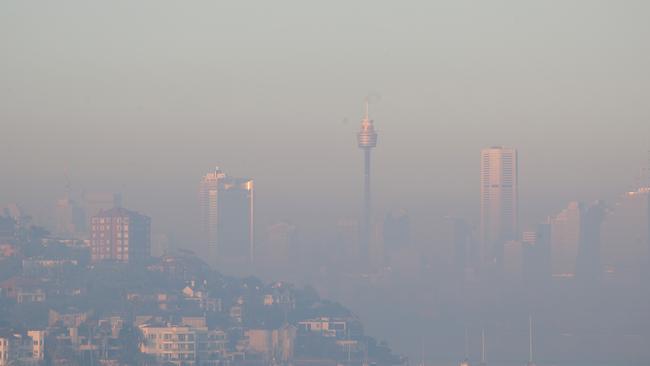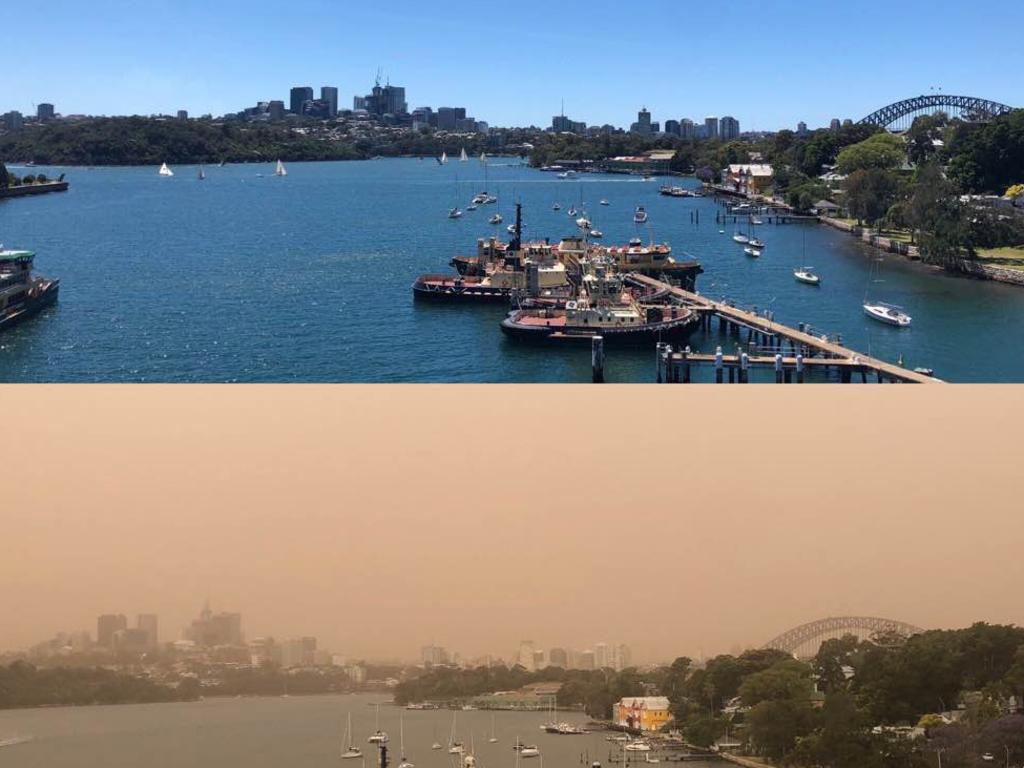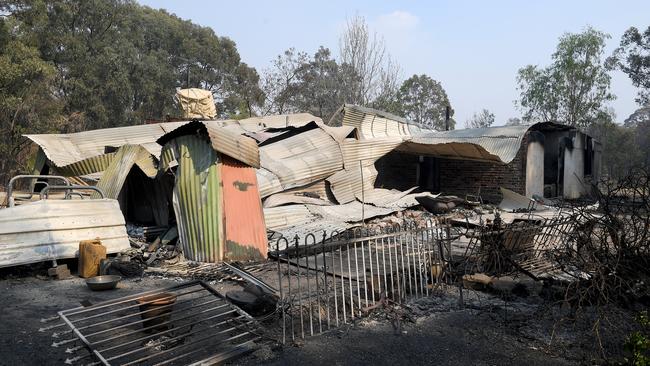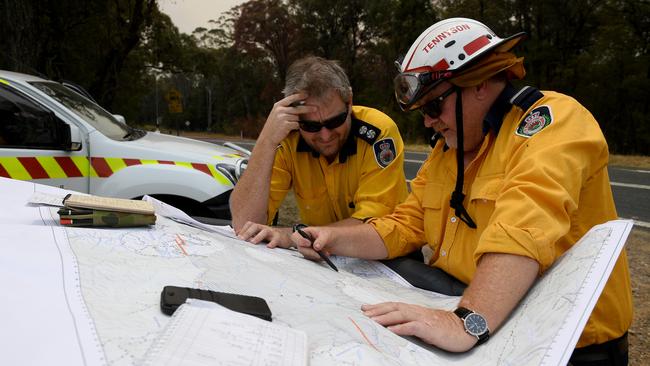Sydney smoke: Haze hits city amid NSW bushfires danger warnings
Thick smoke has blanketed Sydney, forcing dozens of people to seek help from paramedics for breathing issues as a looming thunderstorm presents ‘tough’ conditions for fatigued firefighters.
NSW
Don't miss out on the headlines from NSW. Followed categories will be added to My News.
Sydney’s air quality is today the worst in the world at almost 16 times safe levels.
Health authorities have urged asthma sufferers across Sydney to stay inside as a thick blanket of bushfire smoke settles across the region and firefighters brace for a difficult few days with temperatures set to rise into the high 30s.
Sydney’s air quality on Tuesday is among the lowest in the world – with NSW Environment’s air quality measurements reading 800 micrograms of PM2.5 per cubic metre of air at around 9am in Sydney’s North-West – eight times worse than Jakarta and Beijing.
Safe levels of PM2.5, an air pollutant which causes breathing difficulties, are considered to be between 34-66.


The reading makes the city’s air quality the worst in the world and four times as bad as Kolkata’s which today sits at 190, according to the real-time Air Quality Index.
Jakarta’s notoriously polluted air today measures at 119 while Beijing’s measures at 155.
Residents are urged to take care, with the haze set to linger into the tail end of the week.
At just 1pm, more than 44 people have been treated by paramedics for breathing problems and asthma, according to NSW Ambulance.
Dr Richard Grim from NSW Health urged everyone to stay indoors – particularly those with respiratory problems – noting an increase in hospitalisations, and even deaths, on hazy days.
“The air quality in Sydney and over much of NSW is very poor at the moment so it’s important for people to be cautious,” he said.

Anne Farrell from the Bureau of Metereology said we “aren’t going to be out of the woods” for a few days, with the haze set to linger until at least Thursday.
The thick haze, blown in from a fire raging at Wollemi National Park, could be smelt and seen Sydney-wide on Tuesday morning.
Sydney’s east, northwest slopes and parts of the southwest are choking through hazardous levels while other parts of the state are struggling through very poor and poor ratings.
The level of PM2.5 levels sat at 343 in Sydney’s East, 806 in Sydney’s North-West and 324 in the North — West Slopes at lunchtime.
The particles can trigger breathing problems in people with asthma, emphysema and angina.
Those with respiratory or heart conditions are being urged to stay indoors with windows closed, use reliever medication where necessary, avoid vigorous exercise and cover their nose and mouth with a mask.
Asthmatics aren’t the only ones to struggle through the haze, with the particles causing sore eyes, nose and throat for others.
Symptoms can last for several days.
Take the quiz: Is this Sydney or Beijing?
The hot and windy conditions have sparked concerns 56 fires burning across the state could flare up and total fire bans have been declared in multiple regions.
Residents in bushfire-prone areas are being told to monitor conditions and action their bushfire emergency plans.
More than 20 schools across the state will be temporarily closed due to the bushfire threat.
Temperatures are set to climb to 39C in Penrith and winds are set to lash the state with gusts of 30-50km/h before easing in the evening.
Fire danger ratings have hit severe in the Greater Hunter, Sydney, Illawarra, Southern and Central Ranges, where a total fire ban is in place, and Very High and Severe across most of the state.
More than 1300 firefighters are working to keep the fires at bay, with 28 yet to be contained.

A southerly change later in the day is set to bring temperatures down before heatwave conditions hit fire grounds again on Thursday.
Strong gusts, lightning and little rain will create difficult conditions for crew. Anne Farrell from the Bureau of Meteorology said changing wind directions in particular will make firefighting “more challenging.”
“There’s a set of ingredients there that are going to make fire fighting conditions challenging,” she said.
Already six lives and 530 homes have been lost since the state’s bushfire season began just weeks ago, with more than 420 homes destroyed in the past fortnight.
The fires have burnt through 1.6 million hectares of land – more land loss than the entire 1993/1994 season.
Firefighters were on Monday battling a firefront of some 6000km, the equivalent distance of a return Sydney-Perth trip, RFS Deputy Commissioner Rob Rogers said.
Mr Rogers said firefighters were “singularly focused” on preventing further loss of life and property and warned people to stay alert.

He urged anyone who had not yet been affected by bushfires to “please use this as a wake-up call”, warning them to take steps including cleaning out gutters and having a fire safety plan in place.
Premier Gladys Berejiklian asked everyone to “maintain their vigilance”. Emergency Services Minister David Elliott said the biggest risk in the coming days would be firefighters becoming fatigued.
A DC10 air tanker had been drafted in from North America to help drop up to 38,000 litres of water and retardant on blazes and efforts will be bolstered by help from New Zealand firefighters, Mr Elliott said.

